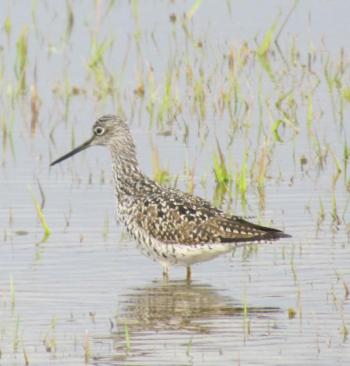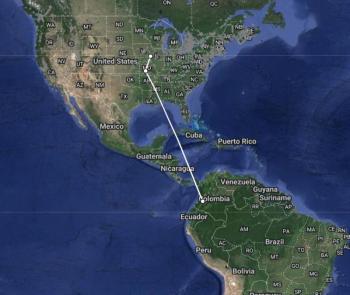A Mellow Tu-Tu-Tu Can Only Mean One Thing
A mellow “tu-tu-tu” echoing across the mudflats at low tide. The smell of salt and fragrant pine and spruce in the air. The spring sun trying valiantly to warm the still nippy morning air.
It’s a classic April morning on the Maine coast as a greater yellowlegs comes gliding in to land on the shore after flying all night from hundreds of miles to the South. Many-a-person may recognize that distinctive “tu-tu-tu” call as part of the audioscape of the Maine coast without knowing the name of the bird species that utters it: the greater yellowlegs.
Greater yellowlegs stand a little over a foot in height on long, bright yellow legs that are ideal for wading in shallow waters while they snatch tiny prey items with their long, thin bill. Their plumage is not spectacular by showy bird standards—none of the flashy orange of a Baltimore oriole or the deep red of a northern cardinal. Instead, it’s subtle shades of grays and blacks, with white on the back, neck, and wings arrayed in spots and bars. In flight, the half of the tail closest to the body shows bright white, giving an appearance of a white rump, even though it’s the tail itself that’s actually white.
Greater yellowlegs nest to our North in the boggy wetlands of the immense Boreal Forest, from Newfoundland in the east extending across Canada to southern Alaska. The wintering range is similarly expansive, from the southern U.S. to southernmost South America.
Audubon scientists from Colombia, working with some visiting Audubon scientists from California, captured and placed radio tags on two greater yellowlegs in January this year. The birds were using wetlands in the agricultural areas of the Cauca Valley near Cali where Audubon is working with farmers interested in managing their lands to make them more bird-friendly.
One greater yellowlegs was last detected in the agricultural wetlands of the Cauca Valley on February 23, but it undoubtedly stayed in the area until March 8. That’s when it was detected from a new radio tower (a MOTUS tower, as we have written about before, flying northwest across the Andes to start its spring migration. The next day it passed by a tower in southwestern Costa Rica, 600 miles away!
A second greater yellowlegs was last detected in Colombia on March 2. It was not detected again until March 31 when it was 2,500 miles farther north, in central Missouri. By the next day (April 1) it had traveled 240 miles farther north to southern Iowa—maybe it was hoping to get back in time to see the famed University of Iowa State women’s basketball team play their last home game with superstar Caitlin Clark?
Maps of observations of greater yellowlegs as of April 1 show that the birds have reached to the northern U.S.—except here in Maine. But the species was being seen just across the border in New Hampshire and Massachusetts, so by the time this column appears, birders will probably have spotted them in southern Maine, at least.
We’ll keep an eye on the detections of these two Colombian-tagged greater yellowlegs and let you know in a later column if and we learn more amazing stories from tracking their migration north to the Boreal and south again in late summer and fall.
Jeffrey V. Wells, Ph.D., is a Fellow of the Cornell Lab of Ornithology and Vice President of Boreal Conservation for National Audubon. Dr. Wells is one of the nation's leading bird experts and conservation biologists. He is a coauthor of the seminal “Birds of Maine” book and author of the “Birder’s Conservation Handbook.” His grandfather, the late John Chase, was a columnist for the Boothbay Register for many years. Allison Childs Wells, formerly of the Cornell Lab of Ornithology, is a senior director at the Natural Resources Council of Maine, a nonprofit membership organization working statewide to protect the nature of Maine. Both are widely published natural history writers and are the authors of the popular books, “Maine’s Favorite Birds” (Tilbury House) and “Birds of Aruba, Bonaire, and Curaçao: A Site and Field Guide,” (Cornell University Press).


























